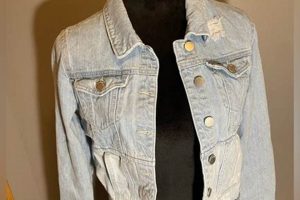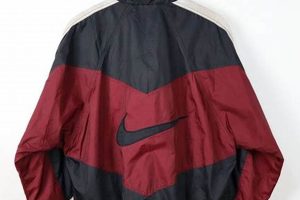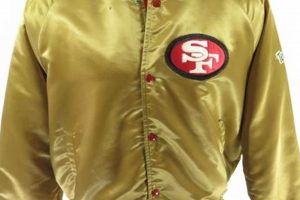A collectible garment representing the Miami Dolphins American football team, typically produced several decades ago, is characterized by features reflecting the design trends and manufacturing techniques prevalent during its original era. These articles of clothing are often sought after by sports memorabilia enthusiasts and fashion collectors.
The significance of these items extends beyond their functional purpose as outerwear. They embody a tangible connection to the team’s historical performance, iconic players, and cultural impact. Their value is derived from rarity, condition, and the specific era they represent, reflecting fluctuations in demand and appreciation among collectors. They provide insights into evolving styles and team branding over time.
The following sections will delve into specific aspects of these vintage items, including identifying authentic examples, assessing their value, and understanding their place within the broader market for sports-related collectibles.
Guidance on Identifying Authentic Garments
The following points offer practical advice for distinguishing genuine retro Miami Dolphins outerwear from contemporary reproductions or counterfeit items.
Tip 1: Examine Manufacturing Tags: Authentic vintage examples will possess tags reflecting the era of production. Look for brand names and logos prevalent during the garment’s purported age, such as Starter, Chalk Line, or Apex One, and verify the presence of union labels characteristic of US-made apparel from that period.
Tip 2: Assess Material Quality: The materials used in vintage jackets often differ from modern fabrics. Original satin jackets will have a distinct sheen and texture, while older nylon shells will lack the water-resistant treatments common in contemporary outerwear. Examine the fabric for signs of age-appropriate wear, such as subtle fading or slight imperfections.
Tip 3: Scrutinize Stitching and Construction: Manufacturing techniques have evolved over time. Vintage jackets may exhibit stitching patterns and construction methods that are no longer standard. Look for single-needle stitching, less precise seams, and potentially visible raw edges inside the garment.
Tip 4: Investigate the Graphics: Logos, lettering, and artwork on vintage pieces were typically applied using screen-printing or direct embroidery. Evaluate the quality and consistency of the printing or embroidery. Authentic examples will display slight imperfections, color variations, or cracking due to age and wear.
Tip 5: Evaluate Hardware and Fasteners: Zippers, snaps, and buttons on vintage jackets will often have a different appearance and construction than modern components. Look for brand names on zippers, signs of tarnishing or oxidation on metal parts, and unique button designs specific to the era.
Tip 6: Compare to Known Authentic Examples: Cross-reference the garment with images and descriptions of authenticated vintage Miami Dolphins jackets from reputable sources, such as online archives, collector forums, or auction house catalogs. Pay close attention to details like color schemes, design elements, and manufacturer markings.
Tip 7: Consult with Experts: If uncertainty persists, seek the opinion of knowledgeable collectors or appraisers specializing in vintage sports apparel. They can provide expert insights and authentication services.
Adhering to these guidelines increases the likelihood of identifying a genuine vintage Miami Dolphins jacket, minimizing the risk of acquiring a misrepresented item.
The subsequent sections will explore aspects such as the financial value associated with such items.
1. Authenticity verification
The accurate determination of a garment’s origin and era is paramount when assessing a vintage Miami Dolphins jacket. Misidentification can significantly impact the item’s perceived value and desirability among collectors. Established methodologies are employed to differentiate genuine articles from reproductions or counterfeit items.
- Tag and Label Analysis
Examination of internal tags and labels provides crucial insights. Authentic vintage jackets will feature tags from manufacturers prevalent during the item’s purported era. Identifying trademarks, care instructions, and union labels consistent with the period is essential. For example, the presence of a “Made in USA” tag accompanied by a union label suggests pre-NAFTA production, while specific manufacturer codes can be cross-referenced against historical records.
- Material Composition Assessment
The fabrics used in manufacturing vintage apparel differ from modern materials. A genuine satin jacket from the 1980s will exhibit a distinct sheen and weight compared to contemporary reproductions using synthetic blends. Evaluating the fabric’s texture, drape, and overall feel provides clues about its authenticity. The presence of specific fiber blends or weaving patterns associated with particular eras can further validate the item’s origin.
- Construction and Stitching Techniques
Manufacturing processes evolve over time. Vintage jackets often display construction techniques no longer commonly used. Observing stitching patterns, seam finishes, and hardware components can reveal inconsistencies that indicate potential inauthenticity. For example, single-needle stitching was prevalent in earlier production runs, whereas overlock or serged seams are characteristic of later garments. The type and placement of zippers, snaps, and buttons also offer valuable clues.
- Logo and Graphic Reproduction
Logos, lettering, and artwork on vintage jackets were typically applied using screen-printing or embroidery techniques. Analyzing the quality, resolution, and color accuracy of these graphics is crucial. Authentic examples may exhibit slight imperfections, color variations, or fading due to age and wear. Examining the stitch density, thread type, and registration of embroidered logos can reveal inconsistencies indicative of unauthorized reproduction. Comparisons with documented examples are essential.
The interplay of these factors determines the credibility of any given vintage Miami Dolphins jacket. Thorough assessment employing these techniques strengthens the verification process, protecting buyers and preserving the integrity of the vintage market.
2. Material composition
The constituent materials of a retro Miami Dolphins outerwear piece are a critical determinant of its authenticity, value, and historical significance. The fabrics, linings, and hardware utilized during the manufacturing era provide key insights into the garment’s origin and manufacturing period.
- Outer Shell Fabric Types
Vintage Miami Dolphins jackets were commonly constructed from a variety of materials, each reflecting the prevailing styles and technologies of its time. Satin, nylon, and cotton blends were frequently used for the outer shell. Examining the fiber content and weave pattern can provide clues to the jacket’s age. For instance, early satin jackets often featured a distinct sheen and heavier weight compared to later nylon variations. The presence of specific fiber blends or coatings can further refine the estimated production period.
- Lining Materials
The lining materials employed in vintage jackets offer additional markers of authenticity. Quilted linings, flannel, and lightweight nylon were commonly used. The type and quality of the lining can indicate the jacket’s intended purpose and price point. Examining the stitching and attachment methods of the lining can also reveal details about the manufacturing processes used. For example, a coarsely stitched or loosely attached lining may suggest an earlier or less expensive production run.
- Hardware Components
Zippers, snaps, and buttons are integral components of vintage jackets and offer valuable clues about their origin. The brand and style of zippers, the material and design of snaps, and the type of buttons used can all be indicative of a specific manufacturing period. For example, certain zipper brands were prevalent during specific decades, and their presence on a jacket can help to narrow down its age. The material composition of the hardware, such as the use of brass or nickel, can also provide insights.
- Deterioration Patterns
The way in which different materials age and deteriorate over time provides additional information about a vintage garment. Satin may develop snags or runs, nylon may become brittle or discolored, and cotton may fade or develop stains. Observing these patterns of wear can help to authenticate the jacket and assess its overall condition. The presence of specific types of damage or deterioration can also be indicative of the jacket’s usage history and storage conditions.
The interplay of these factors contributes to a comprehensive understanding of a garment’s material composition, directly influencing its authentication and valuation within the market for vintage Miami Dolphins outerwear. The accurate identification of materials, in conjunction with other authentication methods, is essential for collectors and enthusiasts seeking to acquire genuine and historically significant items.
3. Era specific designs
The design characteristics of a retro Miami Dolphins garment are inextricably linked to the period in which it was manufactured. These stylistic choices, encompassing color palettes, logo renditions, and overall aesthetic, serve as critical markers for authentication and valuation. Each era within the team’s history is associated with specific design trends that can be identified and analyzed. For instance, jackets produced during the team’s dominant years in the 1970s often feature a more minimalist aesthetic, employing the classic aqua and orange color scheme with simpler logo applications. The “flying dolphin” logo, prominent during that period, is a defining design element. Conversely, jackets from the 1990s may incorporate bolder graphic elements, more complex color schemes, and larger, more prominent logo placements, reflecting the design sensibilities of that decade. These era-specific design choices are not arbitrary; they are a direct reflection of contemporary fashion trends and branding strategies employed by the team and its licensed apparel manufacturers.
Understanding these design distinctions is of practical significance for collectors and enthusiasts. The ability to accurately identify the era of a jacket based on its design features allows for a more informed assessment of its authenticity and potential value. For example, a jacket purporting to be from the 1970s that features design elements characteristic of the 1990s would raise immediate red flags, suggesting a reproduction or counterfeit item. Conversely, a jacket that exhibits all the design cues consistent with its claimed era, such as the correct logo style, color palette, and font usage, lends greater credibility to its authenticity. This knowledge also enables collectors to specialize in specific periods of the team’s history, focusing their acquisitions on garments that represent particular eras or iconic moments.
In summary, era-specific designs are a fundamental component of any retro Miami Dolphins jacket, serving as a key identifier for authentication and valuation purposes. The ability to recognize and interpret these design cues is essential for collectors and enthusiasts seeking to acquire genuine and historically significant items. While challenges may arise in accurately dating garments due to subtle variations or transitional designs, a thorough understanding of design trends across different eras remains crucial for navigating the market for vintage sports apparel.
4. Collectibility factors
The allure of vintage Miami Dolphins jackets transcends mere functional outerwear, becoming objects of significant collectibility. Several factors converge to determine the desirability and market value of these items among enthusiasts and collectors.
- Rarity and Scarcity
The limited production runs of certain jacket styles, particularly those associated with specific seasons or events, contribute significantly to their collectibility. Jackets produced for championship years, Super Bowl appearances, or special anniversaries are inherently rarer and more sought after. The scarcity of a particular design, due to limited initial production or attrition over time, directly impacts its market value and desirability among collectors seeking to complete specific sets or acquire unique pieces.
- Condition and Preservation
The physical condition of a vintage Miami Dolphins jacket is a primary determinant of its collectibility. Jackets in pristine, unworn condition command a premium, while those exhibiting significant wear, damage, or alterations are generally less desirable. Factors such as fading, staining, tears, and missing components (zippers, snaps, buttons) detract from a jacket’s value. Proper storage and preservation techniques are crucial for maintaining a jacket’s condition and maximizing its collectibility over time.
- Historical Significance and Association
Jackets linked to pivotal moments in the team’s history, iconic players, or significant cultural events hold greater collectibility. Jackets worn or associated with legendary players like Dan Marino or Don Shula possess enhanced value due to their connection to these figures. Jackets commemorating Super Bowl victories or other championship seasons also carry significant historical weight, appealing to collectors seeking tangible links to the team’s legacy. The documented provenance and historical context of a jacket directly influence its desirability and market value.
- Design and Aesthetics
The visual appeal and design elements of a vintage Miami Dolphins jacket play a crucial role in its collectibility. Jackets featuring unique color combinations, distinctive logos, or aesthetically pleasing design patterns are often more sought after by collectors. Styles that reflect the fashion trends of their respective eras, while also incorporating enduring design principles, tend to be more desirable. The overall aesthetic and visual appeal of a jacket, in conjunction with its other attributes, contribute to its collectibility and market value.
These factors collectively influence the demand and market value of vintage Miami Dolphins jackets. The interplay of rarity, condition, historical significance, and design aesthetics determines a jacket’s collectibility, shaping the perceptions and valuations among enthusiasts and collectors. Understanding these factors is crucial for both buyers and sellers navigating the market for these historically significant garments.
5. Market valuation
The financial assessment of a vintage Miami Dolphins jacket is a multifaceted process influenced by a convergence of tangible and intangible factors. Accurate valuation requires a thorough understanding of the garment’s attributes, historical context, and prevailing market trends.
- Condition Assessment and Grading
The physical condition of a jacket is a primary driver of its market value. Established grading scales, ranging from “Mint” to “Poor,” are utilized to assess the garment’s overall state. Factors considered include the presence of tears, stains, fading, missing components, and alterations. Jackets in pristine condition command significantly higher prices than those exhibiting substantial wear or damage. Third-party grading services provide independent assessments that can enhance buyer confidence and facilitate transactions.
- Provenance and Historical Significance
The documented history and associated significance of a jacket can substantially impact its market value. Jackets directly linked to prominent players, iconic games, or significant team achievements are highly sought after by collectors. Provenance documentation, such as letters of authenticity, photographs, or game-used tags, bolsters the jacket’s credibility and enhances its desirability. The historical context surrounding a particular jacket style or design also influences its valuation, reflecting the prevailing cultural and sporting trends of its era.
- Rarity and Scarcity
The limited availability of certain jacket styles or designs directly influences their market value. Jackets produced in small quantities, or those that have become scarce due to attrition over time, command premium prices. Factors contributing to rarity include limited-edition releases, promotional items, and designs associated with specific seasons or events. The perceived scarcity of a particular jacket among collectors drives demand and ultimately impacts its market valuation.
- Market Trends and Collector Demand
Prevailing trends within the sports memorabilia market, and the specific demand for Miami Dolphins collectibles, significantly influence the valuation of vintage jackets. Fluctuations in team performance, player popularity, and overall collector interest can impact the prices realized for these items. Tracking auction results, online marketplaces, and collector forums provides insights into current market trends and demand levels. Understanding these dynamics is crucial for accurately assessing the market value of a vintage Miami Dolphins jacket.
The convergence of these factorscondition, provenance, rarity, and market trendsdetermines the financial valuation of a vintage Miami Dolphins jacket. Accurately assessing these elements requires expertise, diligence, and a thorough understanding of the sports memorabilia market. A comprehensive valuation considers both the tangible attributes of the garment and its intangible historical significance, reflecting its place within the broader landscape of sports collecting.
Frequently Asked Questions
This section addresses common inquiries regarding authenticating, valuing, and caring for vintage Miami Dolphins jackets.
Question 1: What are the primary indicators of authenticity in vintage Miami Dolphins outerwear?
Authenticity is primarily determined by examining manufacturing tags, assessing material composition, scrutinizing stitching techniques, and verifying the accuracy of logo and graphic reproduction relative to known historical examples.
Question 2: How does the condition of a vintage Miami Dolphins jacket impact its market value?
Condition is a critical factor. Jackets in pristine, unworn condition command a premium, while those with significant wear, damage, or alterations are valued considerably lower. Factors such as fading, staining, tears, and missing components detract from a jacket’s value.
Question 3: Which manufacturers are most commonly associated with authentic vintage Miami Dolphins jackets?
Prominent manufacturers include Starter, Chalk Line, and Apex One, among others. The presence of these brands, along with union labels characteristic of the garment’s purported era, can support authentication efforts.
Question 4: How can the age of a vintage Miami Dolphins jacket be determined?
The age can be estimated by analyzing design elements, logo styles, fabric composition, and manufacturing techniques consistent with specific periods in the team’s history. Cross-referencing these characteristics with documented examples is essential.
Question 5: What is the best method for preserving a vintage Miami Dolphins jacket to maintain its value?
Proper storage is crucial. It is recommended to store the jacket in a cool, dry environment away from direct sunlight and excessive humidity. Acid-free garment bags and archival-quality storage materials can further protect the garment from damage.
Question 6: Where is the most reliable venue to purchase an authentic vintage Miami Dolphins jacket?
Reputable auction houses, established sports memorabilia dealers, and trusted vintage clothing vendors are generally considered the most reliable sources. Thoroughly vetting the seller’s reputation and authentication processes is crucial prior to making a purchase.
These FAQs provide a foundational understanding of key considerations when engaging with vintage Miami Dolphins outerwear. Due diligence remains paramount in ensuring authenticity and maximizing long-term value.
The subsequent section will provide actionable steps and precautions when buying such an item.
Conclusion
The preceding sections have explored various facets of the vintage Miami Dolphins jacket, encompassing authentication methodologies, material composition analysis, era-specific design identification, collectibility determinants, and market valuation considerations. Accurate identification and assessment require a multifaceted approach, combining meticulous examination with a comprehensive understanding of historical context and market dynamics.
Navigating the market for a vintage Miami Dolphins jacket demands diligence and informed decision-making. Prospective buyers are encouraged to prioritize thorough authentication processes and seek guidance from reputable experts. The enduring appeal and historical significance of these garments warrant careful attention to detail, ensuring both preservation and appreciation of these tangible artifacts of sports history.







